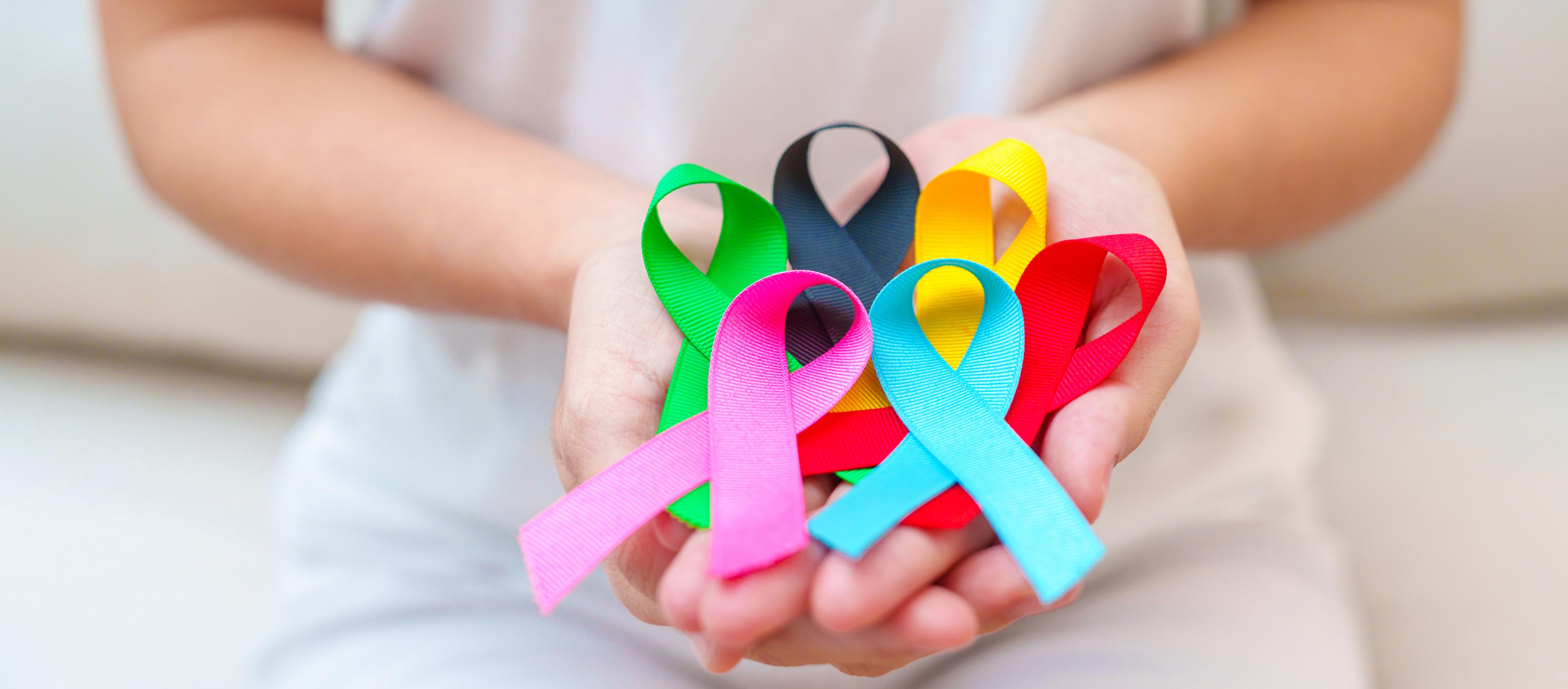Cancer Ribbon Colors and Meanings
A Healthier Michigan
| 5 min read

Awareness ribbons for different types of cancer as well as other social or medical issues are popular in America to show support and solidarity with those dealing with the issue. Originally, ribbons were inspired by the 1973s song “Tie a Yellow Ribbon Round the Ole Oak Tree.” American Penney Laingen tied a yellow ribbon around a tree in her yard to raise awareness of the 1979 Iranian hostage crisis.
Since then, different colors or arrangements of ribbons have been used to show support for various issues, especially for different types of cancer. The cancer ribbons cover a range of colors, each connected to one of the more than 100 types of cancers or sub-cancers. Here are some of the more commonly recognized cancer ribbons:
Appendix cancer: amber
August is Appendix Cancer Awareness Month. Appendix cancer is rare and affects only between one and two Americans per million. It is most diagnosed between the ages of 50 and 55 but can occur at any age.
Bladder cancer: purple, yellow and navy
The bladder cancer ribbon has a different color for each side of the ribbon – the front of the ribbon is purple, the back is yellow and the loop on top is navy. Bladder cancer awareness is observed in May. Bladder cancers make up around 4% of all cancers in America. More than 80,000 Americans are expected to have been diagnosed with bladder cancer in 2024.
Blood cancer: red
Blood cancer awareness is in September, so you may see a variety of red ribbons during that month. There are variations or trims on the red ribbon for blood cancer that denote specific types of blood cancer:
- Orange for leukemia
- Violet for Hodgkin Lymphoma
- Lime green for non-Hodgkin Lymphoma
- Burgundy for Myeloma
Blood cancers make up nearly 10% of all newly diagnosed cancer cases in the United States. An estimated 1.5 million Americans are living with active blood cancer or with cancer in remission.
Bone cancer: yellow
You may see these more during July, which is Bone Cancer Awareness Month. Bone cancer is very rare, with fewer than 4,000 cases expected to have been diagnosed in 2024.
Brain cancer: gray
You are likely to see ribbons that show support for brain cancer patients and their families, especially during May, which is Brain Cancer Awareness Month. Slightly more than 25,000 new cases are expected in 2024.
Breast cancer: pink
Pink ribbons are the best-known cancer ribbon because of their use for Breast Cancer Awareness Month in October. It is one of the more common cancers – the average American woman has a 13% chance of developing breast cancer at some point. Rates of breast cancer are gradually rising in America, with slightly higher rates in women under the age of 50.
Childhood cancers: gold
Nearly 10,000 new cancer cases in American children were expected for 2024. Survival rates for childhood cancers have increased for than 50% since the 1970s.
Colorectal cancer: dark blue
Colorectal Cancer Awareness Month is recognized in March. One in 23 American men and one in 25 American women develop colorectal cancer. Survival rates have steadily improved during the past 50 years because of increased screenings and improved care.
Head and neck cancer: burgundy and white
For head and neck cancers, usually, the front side of the ribbon is white, and the back loop is burgundy. More than 70,000 Americans will have been diagnosed with a head or neck cancer by the end of 2024, accounting for around 4% of all new cancer cases.
Kidney cancer: orange
Kidney Cancer Awareness Month is in March. Kidney cancer is one of the 10 most common cancers in America. It accounts for between 4% and 5% of all new cancer cases in America, expected to affect more than 80,000 Americans in 2024, with almost two thirds of these cases being men.
Liver cancer: green
Liver cancer awareness is in October. Liver cancer is one of the leading causes of deaths from cancer worldwide, although rates in America are lower than in other areas of the world. This may be in part because most liver cancers are diagnosed between ages 55 and 75.
Lung cancer: pearl or white
Lung cancer awareness is in November. Lung cancer is the second most common type of cancer for Americans. More than 230,000 new cases and more than 125,000 deaths from lung cancer are expected in 2024. It has one of the lower survival rates for cancers. More Americans die from lung cancer than from prostrate, colon and breast cancer combined.
Pancreatic cancer: purple
November is Pancreatic Cancer Awareness Month. Pancreatic cancer accounts for around 3% of new cancer cases and 7% of cancer deaths in the United States. It affects men and women at similar rates.
Prostate cancer: light blue ribbon
September is Prostate Cancer Awareness Month. Prostate cancer is the most commonly diagnosed cancer in American men. Nearly 300,000 cases are expected in 2024.
Skin cancer: black
Skin Cancer Awareness Month is in May. Skin cancer is the most common cancer overall in the United States. One in five Americans will develop a form of skin cancer at some point in their life. An estimated 9,500 Americans are diagnosed with skin cancer each day.
Thyroid cancer: purple, teal and pink
September is Thyroid Cancer Awareness Month. Nearly 45,000 Americans were expected to have a new thyroid cancer diagnosis in 2024. Thyroid cancer affects women at nearly three times the rate of men.
Image: Getty Images
Related:





